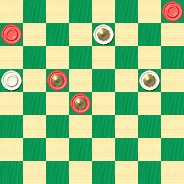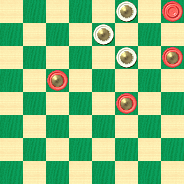The Checker Maven
Jump to navigationTriple Threat

The term "Triple Threat" has a number of meanings, arising at least originally in the world of sports. The one we knew about was a football triple threat--- someone who can run, pass, and kick, as we recall. Apparently there is a triple threat position in basketball, with which we are wholly unfamiliar. And other uses abound, both in and out of sports, but with similar intent. Above, we have pictured a band called Triple Threat, who have played in the Boston, Massachusetts area. We imagine they base their band's name on the fact that there are three members. But when we tried to find out more, we soon discovered that numerous other bands around the United States are also called "Triple Threat."
Our checker school "Triple Threat" follows a similar pattern. We have three different checker positions, which have some similarities: Black has four pieces to White's three, and the formations are at least somewhat alike. But as we know, small differences are everything in checkers, and so in two of the positions White can draw but in the third, White is lost.
BLACK

WHITE
White to Play and Draw
W:WK7,13,K16:B4,5,K14,K18.
BLACK

WHITE
White to Play and Draw
W:WK3,K11,K14:BK4,5,K23,K24.
BLACK

WHITE
Black to Play and Win, 2 Ways
Black shown at top for consistency
with other positions
B:WK3,K7,K11:B4,K12,K14,K19.
Are you yourself a "Triple Threat," which in this case means you can solve all three positions? Or are you a "Double Threat," a "Threat," or "No Threat At All"? Solve the problems, and we promise not to threaten anything if you click on Read More to reveal the solutions, a sample game, and detailed notes.![]()
Solution
The solution, sample game, and lettered notes are from Ben Boland's Famous Positions in the Game of Checkers. Numbered notes are by the editor using the KingsRow checker engine.
Miller: 16-11, 14-17, 7-10, 18-14, 10-7,17-22, 11-16, 22-18, 16-11, 18-23, 11-16, 14-18---A, 7-10---B, 23-27, 16-11, 27-24, 11-16---1, 18-23, 16-11, 24-20, 10-7, 23-18, 7-10. Drawn---2.
Barker: 3-8, 24-20---C, 8-12, 23-19, 11-7, 20-16, 7-2, 16-11, 12-8---3, 19-15, 8-12. Drawn.
Mar: 19-23---D, 11-15, 23-26, 15-11, 26-22, 7-2, 14-10, 2-7, 10-6, 7-2, 6-9, 2-7, 22-17, 7-2, 17-13, 2-7, 9-6, 7-2---E, 4-8*, 11-4, 12-16, 2-9, 13-6, 4-8---F, 6-10. Black Wins---4.
Game: 11-16, 23-18, 16-20, 24-19, 10-14, 26-23, 8-11, 22-17, 7-10, 30-26, 11-16, 28-24, 9-13, 18-9, 13-22, 25-18, 5-14, 18-9, 6-13, 32-28, 10-14, 19-15, 4-8, 26-22, 2-6, 22-18, 6-9, 15-10, 13-17, 10-6, 1-10, 18-15, 10-26, 31-6, 8-11, 6-2, 11-15, 2-6, 14-18, 21-17, 3-7, 6-2, 7-11, 2-7, 18-22, 7-2, 22-26, 2-6, 15-18, 6-9, 26-30, 9-14, 18-22, 14-18, 30-25, 18-14, 25-21, 17-13, 11-15---G, 15-19---H, 24-15, 16-19, 18-25, 21-30, 13-9, 30-26, 27-23, 26-22, 23-16, 9-6 19-23, 6-2, 23-26, 2-7---I, 26-30, 7-11, 30-26, 11-16, 26-30, 16-19, 15-10 22-17---J, 10-7, 17-22, 7-2, 22-17, 2-7, 17-22, 7-10, 22-17, 10-15. Forms the above position, colors reversed, by Miller. A. McHardy, Game No. 33 in his "Relative Positions."
A---23-27, 16-11, 27-24, 11-16, 24-20, 16-11*---K. Drawn.
B---Or 16-11, but not 7-11 which loses as in Note K.
C---24-19 8-12, 23-26, 11-7, 19-15, 7-2, 26-23, now into setting in Kear's Encyclopedia, continue; 2-6, 15-18, 6-9, 18-15, 9-6, 15-11, 6-2, 23-19, 12-8. Drawn.
D---The other way; 19-24, 7-2, 14-18, 2-7, 18-23, 7-2, 23-27, 2-7, 24-20, 7-2, 12-16, 2-7, 27-32, 3-8, 20-24. Black Wins. C. Collins, No. 35 Kear's Encyclopedia.
E---11-15, 4-8, 7-2, 6-9, 2-7, 9-14, 7-2, 14-17, 2-7, 17-22, 7-2, 13-9, 2-7, 9-14, 7-2, 14-18. Black Wins.
F---If 3-8, or 3-7, then 16-12. Black wins by the American Position.
G---To this stage by various authors.
H---Solution to No. 33 by A. McHardy in his "Relative Positions.
I---2-6 26-30 6-9, 30-26, 9-13, 26-23, 15-10, 23-19, 10-6, 20-24, 6-2, 24-27, 2-7, 27-31 7-10 31-26, 13-9, 26-30, 9-6, 30-26---L, 6-2, 26-23, 2-7, 23-18, 7-11, 22-17, 10-7, 17-22, 11-8, 18-23, 8-12, 22-17, 7-3, 17-22, 3-8, 22-17, 29-25, 17-21. Drawn, McHardy.
J---20-24 would run into Mar's position, colors reversed.
K---16-12 forms No. 64 by A. McHardy in his book, colors reversed; 16-12, 14-18, 7-11, 20-24, 12-16, 24-27, 16-12, 27-31, 12-16, 31-26, 16-12, 26-22, 12-16, 22-17, 16-12, 17-14, 12-8, 14-10,8-3, 18-14, 11-16. Black Wins.
L---With White to Play; 10-14, 30-26, 6-10, 26-30, 14-9, now White man on 29 can be a King, forming above position, colors reversed, by C. F. Barker.
1---10-7 would draw here as well, although in most of the solution, the play is extremely precise.
2---White has made optimal use of his central position and Black can make no progress.
3---14-17 also draws, as Black can't advance the man on 5, for instance: 14-17 5-9 2-6 and now if 9-13? then 12-8! and draws. Again, however, White has little latitude through most of the solution.
4---8-4 16-12 4-8 10-15 8-4 15-11 and it's all over.
James Miller's Draw appeared as No. 2318 in the "Glasgow Weekly Herald," Feb. 27, 1904.
To secure the draw, White must: Leave the man on 13; Keep Black off squares 10 and 15; Prevent Black from advancing the man on 4.
An earlier setting of C. F. Barker's Triangle was first published in the "Aberdeen Free Press" in 1898, and later as No. 804 in the "Pittsburgh Dispatch" Oct. 31, 1898. J. Maize the Editor of the "Dispatch" in the November 14th issue gave it the name "Barker's Triangle."
Barker points out in his position, if the King on 4 should get together with the other Black Kings, Black would win by Strickland's (Merry's) Position.
Robert Mar first published his position in the "Weekly Times" Melbourne, Aus. Then it was copied into the Draughts World, Vol. 6, Aug. 1895 as Gem No. 79. The position was set earlier and it was given as an ending from the Defiance, being a correction on the proposed draw on the Famous Yates vs. Wyllie Game. It may be found as above, as No. 35 in Kear's Encyclopedia.
You can email the Webmaster with comments on this article.
